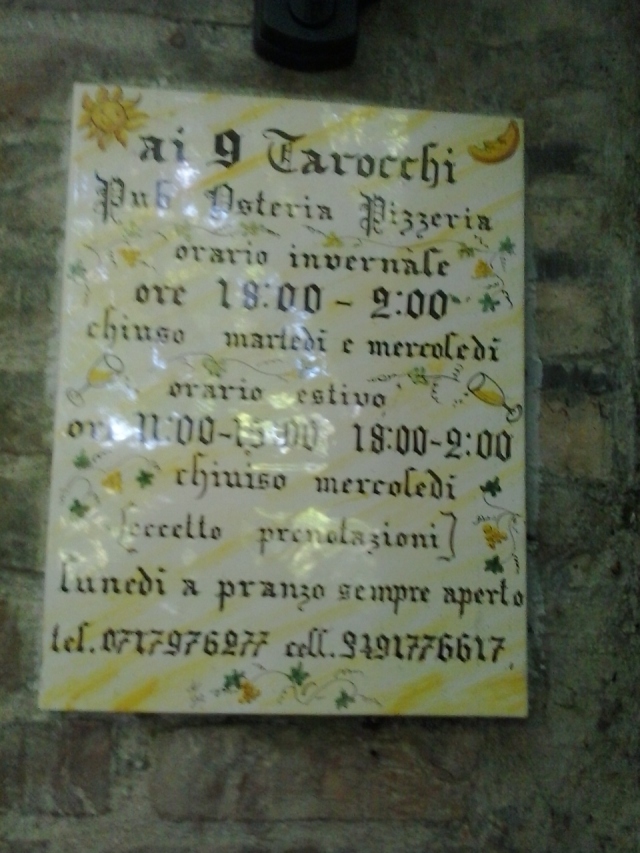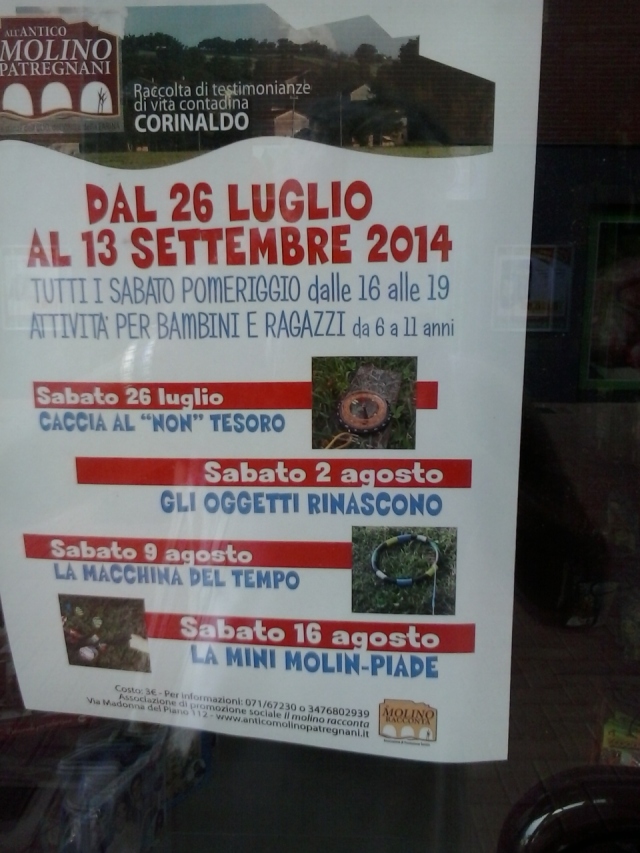Hill towns of Le Marche
The frank guide to towns, sights and where to eat, drink and shop, with advice on how not to end up disappointed, fed up and frustrated.
Welcome to the Marche, between the Apennines and the Adriatic, where the hills swoop surreally up and down, where the people are honest, hard-working and polite, where crime is rare, where the olive and vine are fruitful, where hill-towns are ennobled by spacious piazzas, proud fortresses,
dignified churches
and imposing defensive walls. Why aren’t they better known? Well, Tuscany it’s not. We’re not talking about world class master pieces. It’s the ensemble which counts, the mellow brick against the blue sky.
Moreover, mostly the young people speak English and there are few concessions to non-Italian customs – though tins of baked beans have been spotted for sale in the south of the region. Read a short piece by Anne Treneman, the [London] Times parliamentary sketch-writer in The Times travel section of 15.11.2008, to get an idea of what to expect.
This site aims to give you clues to enjoying the area, whether you have come as a tourist or longer-term resident. We foreigners rely on each other for tips and wrinkles, so even if you know a lot, you may find something helpful here.
I’m a librarian so you will also find information about libraries with historic collections, of which there are a lot in the Marche.
Useful info
Opening hours
If you’ve been to Italy, you’ll know what I mean.. Hot, footsore, thirsty, hungry and what would be cross if you weren’t on an expensive holiday (and the children are cross), you arrive at the local restaurant only to read “Chiuso per ferie” or “Chiuso per turno” or “Aperto ogni giorno tranne lunedi.”
If you didn’t know what Chiuso means you do now! Or still worse, you think you’ll drive down to the village to buy stuff for your first meal. What with one thing and another you don’t get out till 11.45 and by the time you get there the charming little shop is Chiuso dalle 12 alle 15. Or the local art gallery/museum is only open two evenings a week (this is not an exaggeration).
All this applies in spades at Ferragosto, the feast of the Assumption of the Virgin Mary on 15 August, a national holiday. Many establishments close for several days around this date.
What to do
Well, you are reading this which is a good start.
Lead the Italian way of life. They have been living in this country for thousands of years and they have evolved an excellent way of coping with the heat. They do everything early in the morning, before the sun is too fierce – yes, even on holiday – or after 3 pm, when the sun is starting to decline. Between 12 and 3 they are having lunch and a pisolino (nap). They stick to this timetable all year round, even though it can be cold and wet in autumn, winter and spring. So, quite lively towns can seem dead between 12 and 3, to the point of being depressing.
Since writing this I have observed that shops and tourist offices are now often closed till 4 or even 5 pm. I think this is to save staff and other costs because of the recession (la crisi economica).
If you are arriving at an airport or station and hiring a car to reach your destination, stop at a motorway service station and buy the basics. If you are staying in a town and plan to go on foot and use public transport, the chances are you will find somewhere open, outside lunchtime and Sunday. Once you have arrived and settled in, either get out early to your shopping, or at least be in the shop by 11.45. Or do your shopping between 5 and 8 pm. In summer large supermarkets are often open all day “orario continuo” and on Sundays “Aperto anche domenica”.
Eating out
The Marchigiani are hard working. Lots of caffè-bars are open from 7.30 am to 2 am.
(They often serve quite acceptable pasta or salad lunches, by the way.) But they believe in work-life balance, which means that most establishments close one day a week. It’s often Monday. Do a recce before you go out to eat. Walk or drive around a bit (or a lot around 15 August), find at least two restaurants (or more around 15 August) and establish when their closure day is, or whether they are open at all on or around 15 August . Arrive before you’re really hungry. And obviously if you are going to visit a new place, you can’t do all this. Remember what I said about the bars serving ok lunches, and, if you have children, consider eating on the road at the snack-bar or restaurant attached to a service station.
As for sightseeing … well, the Marchigiani have a lot of heritage and they can’t afford to look after it all properly. They choose to spend the money on free entertainments, instead. Don’t rely on anywhere being open, be prepared to be disappointed, and remember that, as an alternative, non-isolated churches are usually open, except between 12 and 3. The sacristan has got to have his lunch. If they are saying Mass you can sit quietly at the back taking it all in if you don’t want to or can’t join in.
Food and eating
It’s a myth that Italians don’t eat ready meals. They do. They buy them at a “rosticceria”. You’ll often see young mums who don’t want to cook after a morning on the beach buying the entire lunch at one of these establishments. They also serve rosticceria-type dishes at supermarket deli counters.
Use them – point at what you want. For pudding they have fresh fruit or buy a dry and stodgy Torta or crostino at the local pasticceria. If you want a nice pudding to eat at home, buy a selection of little cakes, or a semifreddo (ice cream cake) at a caffe or gelateria (ice-cream parlour) or buy an ice-cream to eat in the street at a gelateria. NB Algida is Unilever and you could buy their stuff at home.
Sightseeing
I haven’t listed all the sights; you can usually find these in guidebooks or on the web. Instead I’ve picked out interesting points.
Entertainment (general)
Free
Most hill-towns have an extensive programme of free entertainment in the summer. Visit the tourist office and/or the Pro Loco, study posters,
and buy the local newspaper, Corriere Adriatico or Resto del Carlino. Even if you don’t speak Italian you will find their pull-out “what’s on” sections useful. Don’t rely only on web-sites or printed leaflets. Keep your eyes open generally. Wander along to the main square in the evening.
Paid-for
Particularly noteworthy are pageants, rievocazioni storiche, which involve all or any of:-
the locals dressing up in historic costume and processing about the town, meals cooked and served by local volunteers, competitions involving anything from welly-whanging -or its Italian equivalent -to archery, flag wavers (sbandieratori),
drumming (preceded by regular nocturnal practice), dancing, son et lumiere, fireworks etc. They are great fun. Visit your nearest town’s website to see if they have one.
You pay for these at the historic centre’s main gate. Often it’s the only way of getting in to the old town. You will get an idea of what it was like to enter the town in the past, when, no doubt, even if you had to pay no customs dues, you had to bribe the guards.
Things get a bit quieter outside the summer season, but this is when the local theatres have their programme of theatre (prosa), orchestral music (concerti), and singing and opera (lirica). Le Marche is said to have more theatres than any other Italian region. See the photos below for some of them.
If using the web to find out what’s on, you may need to visit the local commune’s website and navigate to “teatro” or “eventi” for music. A useful site for theatre is http://www.stabilemarche.it/stagioni.asp?id=126 .














We are very impressed by your blog and all the research that has gone into it. we think that Corinaldo is great but hard to get to these days for us…though the summer jazz festival is wonderful. We have lived here in the countryside of Serrungarina for five years now and think this is a ;lovely place to live. if you are in the area do get in touch and we can have a cup of tea together.
best wishes,
Michael Wood
LikeLiked by 1 person
Thanks Michael – we’ll be back in spring.The jazz festival is still going strong.
LikeLike
Pingback: Addio turismo, buongiorno accoglienza . | Hill towns of Le Marche, Italy